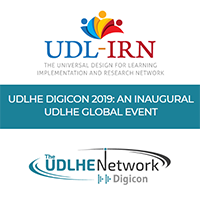
I had the opportunity to attend the UDL-IRN’s UDLHE Digicon. (So many acronyms!) This was a one-day, web-hosted, virtual conference. It is amazing to me how these virtual conferences retain the best parts (and some of the running-between-sessions feelings) of a face-to-face conference.
The day was full of informative sessions. My motivation for attending this conference was to learn strategies for faculty to implement universal design for learning (UDL), strategies to communicate and teach others about the benefits of UDL, and support my current ID2ID project. I am participating in the current cohort of the ID2ID program. The goal of this program is to pair instructional designers together to facilitate a collaborative professional growth opportunity. Each pair is tasked with creating goals to work toward by the conclusion of the program. The goal that my partner, or buddy in ID2ID-speak, are working toward broadly, is to use the UDL framework to support faculty in creating inclusive teaching and learning experiences. This conference directly supports that goal by providing a learning opportunity centered on the topic of UDL.
There were two sessions that resonated with me that I will highlight here. The first was titled “Emphasizing Student Choice, Engagement, & Flexibility in Hybrid Courses.” In it, the presenter Lauren Tucker, outlined the methods and tools that she uses with her students to help them internalize the philosophy of UDL and provide them opportunities to use technology to support a UDL approach. One of the things that Dr. Tucker provides her class and individual students is a UDL Toolkit. This facilitates an opportunity for her students to experience the tools themselves, and to see how they might leverage these tools with their own students (Dr. Tucker’s students are teachers or pre-service teachers.)
The second session that resonated with me was UDL, My Choice: Perspectives and conversations on scaffolding choicemaking, with Denia Bradshaw and Andrew Dell’Antonio. This session resonated with me on a number of levels as I have a music education background. Recalling back to all the hours I spent in lessons and practice rooms made Denia Bradshaw’s portion, talking about how she provides students choice in their one-on-one lessons, more impactful to me. Andrew Dell’Antonio shared about how he increases student choice in his music history course. The students are given four options for how they can show mastery in a course capstone project. This session is particularly pertinent to my ID2ID project goal as my institution has a conservatory. I look forward to sharing and discussing this with the conservatory faculty.